#early daniel and legion
Explore tagged Tumblr posts
Text





Dynamite Comics Sets New Darkwing Duck Series For February 2025
Writer Daniel Kibblesmith is now the terror that flaps in the night, as he’ll be taking over Dynamite’s Darkwing Duck in February, alongside artists Ted Brandt and Ro Stein… Plus “contributions” from original creator, Tad Stones.
“I am the writer who scripts in the night,” Kibblesmith said via press release provided to Comic Book Club. “I am (writing) Darkwing Duck. And I couldn’t feel luckier. Let’s get dangerous — and let’s get pre-ordered!”
The brand new monthly series will bring DD (not Daredevil) back to basics with a “fun approach” that seeks to “ask and answer all the essential questions about the beloved star. How did this avian exemplar develop his redoubtable reputation? What lessons did he learn in his earliest days of foe-foiling? His legion of fans, both within the story and reading these comics, as well as his adopted daughter, Gosalyn, want the lowdown on all these key questions. Darkwing is more than happy to revisit the highlights of his crime-busting career — though there can be no promise that these chronicles will not be embellished, organized, chronological, or verifiable in any way. But they will be a blast!” So yes, this is sort of a Darkwing Duck: Year One, by way of the hero maybe lying about a bunch of stuff.
“I was delighted with Dynamite bringing Darkwing Duck and family back to comics with three, count ‘em three, titles featuring his super pals and his ultimate nemesis, and then they dragged me into the craziness for a bunch of variant covers on this new series,” Stones said. “The stories and art I’ve seen have captured the comedy and adventure of the original series while bringing a fresh take on it all. Thrilled to be a part of it!”
DARKWING DUCK #1
(W) Daniel Kibblesmith (A) Ted Brandt, Ro Stein (CA) Tad Stones
He is the terror that flaps in the night! The fowl that felons most fear! A legend in his own time (and his own mind)! He is… DARKWING DUCK! But how did this avian exemplar develop his redoubtable reputation? What lessons did he learn in his early days of crime-busting and foe-foiling? His legion of fans (or, at least, his adopted daughter, Gosalyn) want to know – and DW is more than happy to tell her the whole (possibly embellished) story in this unauthorized (and unorganized) autobiography!
In Shops: Feb 12, 2025
#Darkwing Duck#Tad Stones#Daniel Kibblesmith#Ted Brandt#Ro Stein#Seth Rogen#Evan Goldberg#The Disney Afternoon#Disney Afternoon#Disney Comics#Dynamite Comics
69 notes
·
View notes
Text
Did the ancient Celts really paint themselves blue?
Part 2: Irish tattoos



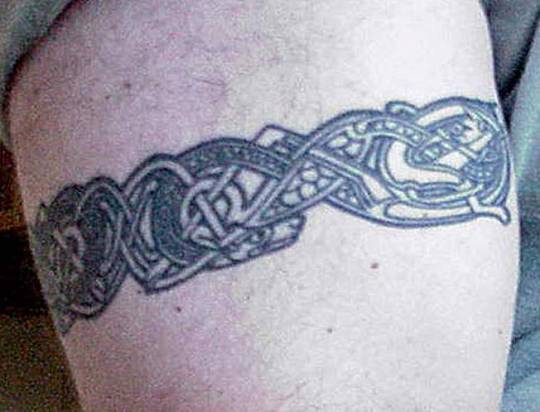
Clockwise from top left: Deirdre and Naoise from the Ulster Cycle by amylouioc, detail from The Marriage of Strongbow and Aoife by Daniel Maclise, a modern Celtic revival tattoo, Michael Flatley in a promotional image for the Irish step dance show 'Lord of the Dance'
This is my second post exploring the historical evidence for our modern belief that the ancient and medieval Insular Celts painted or tattooed themselves with blue pigment. In the first post, I discussed the fact that body paint seems to have been used by residents of Great Britain between approximately 50 BCE to 100 CE. In this post, I will examine the evidence for tattooing.
Once again, I am looking at sources pertaining to any ethnic group who lived in the British Isles, this time from the Roman Era to the early Middle Ages. The relevant text sources range from approximately 200 CE to 900 CE. I am including all British Isles cultures, because a) determining exactly which Insular culture various writers mean by terms like ‘Briton’, ‘Scot’, and ‘Pict’ is sometimes impossible and b) I don’t want to risk excluding any relevant evidence.
Continental Written Sources:
The earliest written source to mention tattoos in the British Isles is Herodian of Antioch’s History of the Roman Empire written circa 208 CE. In it, Herodian says of the Britons, "They tattoo their bodies with colored designs and drawings of all kinds of animals; for this reason they do not wear clothes, which would conceal the decorations on their bodies" (translation from MacQuarrie 1997). Herodian is probably reporting second-hand information given to him by soldiers who fought under Septimius Severus in Britain (MacQuarrie 1997) and shouldn't be considered a true primary source.
Also in the early 3rd century, Gaius Julius Solinus says in Collectanea Rerum Memorabilium 22.12, "regionem [Brittaniae] partim tenent barbari, quibus per artifices plagarum figuras iam inde a pueris variae animalium effigies incorporantur, inscriptisque visceribus hominis incremento pigmenti notae crescunt: nec quicquam mage patientiae loco nationes ferae ducunt, quam ut per memores cicatrices plurimum fuci artus bibant."
Translation: "The area [of Britain] is partly occupied by barbarians on whose bodies, from their childhood upwards, various forms of living creatures are represented by means of cunningly wrought marks: and when the flesh of the person has been deeply branded, then the marks of the pigment get larger as the man grows, and the barbaric nations regard it as the highest pitch of endurance to allow their limbs to drink in as much of the dye as possible through the scars which record this" (from MacQuarrie 1997).
This passage, like Herodian's, is clearly a description of tattooing, not body staining or painting. That said, I have no idea of tattoos actually work like this. I would think this would result in the adult having a faded, indistinct tattoo, but if anyone knows otherwise, please tell me.
The poet Claudian, writing in the early 5th c., is the first to specifically mention the Picts having tattoos (MacQuarrie 1997). In De Bello Gothico he says, "Venit & extremis legio praetenta Britannis,/ Quæ Scoto dat frena truci, ferroque notatas/ Perlegit exanimes Picto moriente figuras."
Translation: "The legion comes to make a trial of the most remote parts of Britain where it subdues the wild Scot and gazes on the iron-wrought figures on the face of the dying Pict" (from MacQuarrie 1997).
Last, and possibly least, of our Mediterranean sources is Isidore of Seville. In the early 7th c. he writes, "the Pictish race, their name derived from their body, which the efficient needle, with minute punctures, rubs in the juices squeezed from native plants so that it may bring these scars to its own fashion [. . .] The Scotti have their name from their own language by reason of [their] painted body, because they are marked by iron needles with dark coloring in the form of a marking of varying shapes." (translation from MacQuarrie 1997)
Isidore is the earliest writer to explicitly link the name 'Pict' to their 'painted' (Latin: pictus) i.e. tattooed bodies. Isidore probably borrowed information for his description from earlier writers like Claudian (MacQuarrie 1997).
In the 8th century, we have a source that definitely isn't Romans recycling old hearsay. In 786, a pair of papal legates visited the Anglo-Saxon kingdoms of Mercia and Northumbria (Story 1995). In their report to Pope Hadrian, the legates condemn pagans who have "superimposed most hideous cicatrices" (i.e gotten tattoos), likening the pagan practice to coloring oneself "with dirty spots". The location of the visit indicates that these are Anglo-Saxon tattoos rather than Celtic, but some scholars have suggested that the Anglo-Saxons might have adopted the practice from the Brittonic Celts (MacQuarrie 1997).
A gloss in the margin of the late 9th c. German manuscript Fulda Aa 2 defines Stingmata [sic] as "put pictures on the bodies as the Irish (Scotti) do." (translation from MacQuarrie 1997).
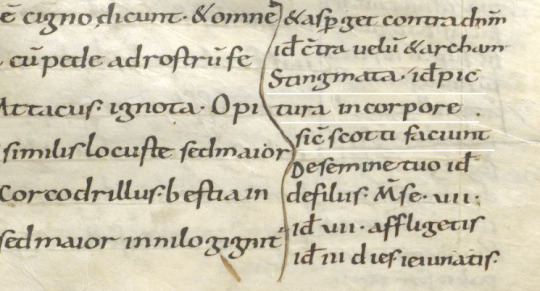
Fulda Aa 2 folio 43r The gloss is on the left underlined in white.
Irish Written Sources:
Irish texts that mention tattoos date to approximately 700-900 CE, although some of them have glosses that may be slightly later, and some of them cannot be precisely dated.
The first text source is a poem known in English as "The Caldron of Poesy," written in the early 8th c. (Breatnach 1981). The poem is purportedly the work of Amairgen, ollamh of the legendary Milesian kings. In the first stanza of the poem, he introduces himself saying, "I being white-kneed, blue-shanked, grey-bearded Amairgen." (translation from Breatnach 1981)
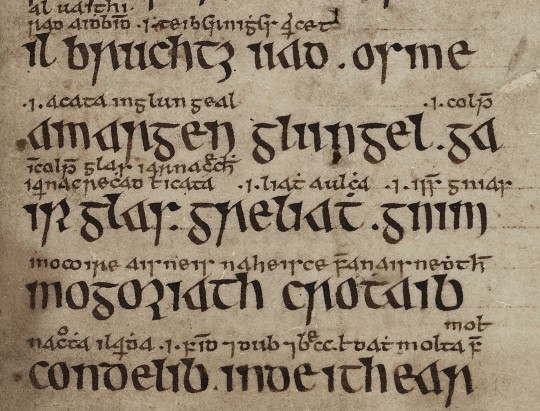
The text of the poem with interline glosses from Trinity College Dublin MS 1337/1
The word garrglas (blue-shanked) has a Middle Irish (c. 900-1200) gloss added by a later scribe, defining garrglas as: "a tattooed shank, or who has the blue tattooed shank" (Breatnach 1981).
Although Amairgen was a mythical figure, the position ollamh was not. An ollamh was the highest rank of poet in medieval Ireland, considered worthy of the same honor-price as a king (Carey 1997, Breatnach 1981). The fact that a man of such esteemed status introduces himself with the descriptor 'blue-shanked' suggests that tattoos were a respectable thing to have in early medieval Ireland.
The leg tattoos are also mentioned c. 900 CE in Cormac’s Glossary. It defines feirenn as "a thong which is about the calf of a man whence ‘a tattooed thong is tattooed about [the] calf’" (translation from MacQuarrie 1997)
The Irish legal text Uraicecht Becc, dated to the 9th or early 10th c., includes the word creccoire on a list of low-status occupations (Szacillo 2012, MacNeill 1924). A gloss defines it as: crechad glass ar na roscaib, a phrase which Szacillo interprets as meaning "making grey-blue sore (tattooing) on the eyes" (2012). This sounds rather strange, but another early Irish text clarifies it.
The Vita sancti Colmani abbatis de Land Elo written around the 8th-9th centuries (Szacillo 2012) contains the following episode:
On another time, St Colmán, looking upon his brother, who was the son of Beugne, saw that the lids of his eyes had been secretly painted with the hyacinth colour, as it was in the custom; and it was a great offence at St Colmán’s. He said to his brother: ‘May your eyes not see the light in your life (any more). And from that hour he was blind, seeing nothing until (his) death. (translation from Szacillo 2012).
The original Latin phrase describing what so offended St Colmán "palpebre oculorum illius latenter iacinto colore" does not contain the verb paint (pingo). It just says his eyelids were hyacinth (blue) colored. This passage together with the gloss from the Uraicecht Becc implies that there was a custom of tattooing people's eyelids blue in early medieval Ireland. A creccoire* was therefore a professional eyelid tattooer or a tattoo artist.
A possible third reference to tattooing the area around the eye is found in a list of Old Irish kennings. The kenning for the letter 'B' translates as 'Beauty of the eyebrow.' This kenning is glossed with the word crecad/creccad (McManus 1988). Crecad could be translated as cauterizing, branding, or tattooing (eDIL). McManus suggests "adornment (by tattooing) of the eyebrow" as a plausible interpretation of how crecad relates to the beauty of the eyebrow (1988). The precise date of this text is not known (McManus 1988), but Old Irish was used c. 600-900 CE, meaning this text is of a similar date to the other Irish references to tattoos.
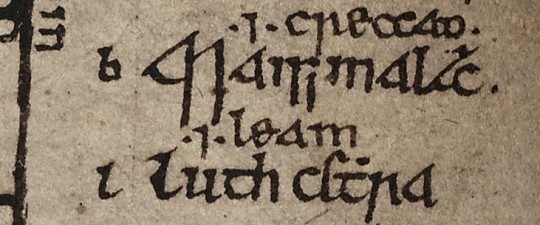
Kenning of the letter 'b' with gloss from TCD MS 1337/1
There is a sharp contrast between the association of tattoos with a venerated figure in 'The Caldron of Poesy', and their association with low-status work and divine punishment in the Uraicecht Becc and the Vita. This indicates that there was a shift in the cultural attitude towards tattoos in Ireland during the 7th-9th centuries. The fact that a Christian saint considered getting tattoos a big enough offense to punish his own brother with blindness suggests that tattooing might have been a pagan practice which gradually got pushed out by the Catholic Church. This timeline is consistent with the 786 CE report of the papal legates condemning the pagan practice of tattooing in Great Britain (MacQuarrie 1997).
There are some mentions of tattooing in Lebor Gabála Érenn, but the information largely appears to be borrowed from Isidore of Seville (MacQuarrie 1997). The fact that the writers of LGE just regurgitated Isidore's meager descriptions of Pictish and Scottish (ie Irish) tattooing without adding any details, such as the designs used or which parts of the body were tattooed, makes me think that Insular tattooing practices had passed out of living memory by the time the book was written in the 11th century.
*There is some etymological controversy over this term. Some have suggested that the Old Irish word for eyelid-tattooer should actually be crechaire. more info Even if this hypothesis is correct, and the scribe who wrote the gloss on creccoire mistook it for crechaire, this doesn't contradict my argument. The scribe clearly believed that eyelid-tattooer belonged on a list of low-status occupations.
Discussion:
Like Julius Cesar in the last post, Herodian of Antioch c. 208 CE makes some dubious claims of Celtic barbarism, stating that the Britons were: "Strangers to clothing, the Britons wear ornaments of iron at their waists and throats; considering iron a symbol of wealth, they value this metal as other barbarians value gold" (translation from MacQuarrie 1997). If the Britons wore nothing but iron jewelry, then why did they have brass torcs and 5,000 objects that look like they're meant to attach to fabric, Herodian?
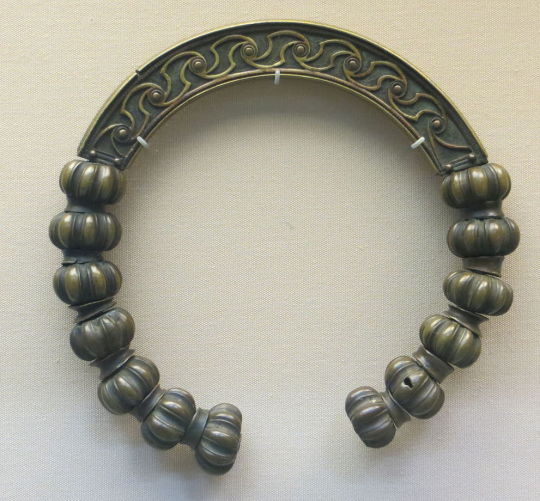
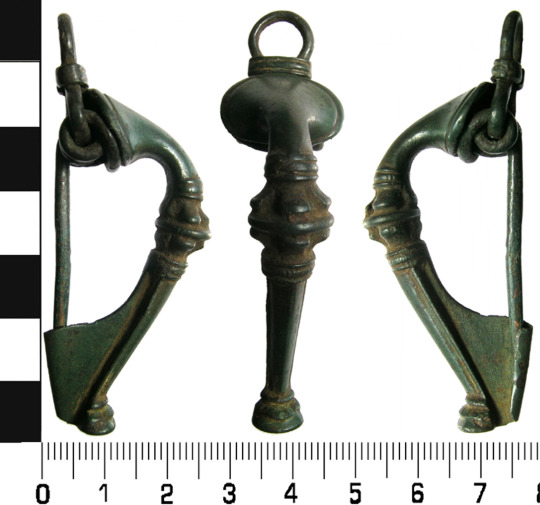
Brass torc from Lochar Moss, Scotland c. 50-200 CE. Romano-British trumpet brooch from Cumbria c. 75-175 CE. image from the Portable Antiquities Scheme.
Trumpet brooches are a Roman Era artifact invented in Britain, that were probably pinned to people's clothing. more info
Although Herodian and Solinus both make dubious claims, there are enough differences between them to indicate that they had 2 separate sources of information, and one was not just parroting the other. This combined with the fact that we have more-reliable sources from later centuries confirming the existence of tattoos in the British Isles makes it probable that there was at least a grain of truth to their claims of tattooing.
There is a common belief that the name Pict originated from the Latin pictus (painted), because the Picts had 'painted' or tattooed bodies. The Romans first used the name Pict to refer to inhabitants of Britain in 297 CE (Ware 2021), but the first mention of Pictish tattoos came in 402 CE (Carr 2005), and the first explicit statement that the name Pict was derived from the Picts' tattooed bodies came from Isidore of Seville c. 600 CE (MacQuarrie 1997). Unless someone can find an earlier source for this alleged etymology than Isidore, I am extremely skeptical of it.
Summary of the written evidence:
Some time between c. 79 CE (Pliny the Elder) and c. 208 CE (Herodian of Antioch) the practice of body art in Great Britain changed from staining or painting the skin to tattooing. Third century Celtic Briton tattoo designs depicted animals. Pictish tattoos are first mentioned in the 5th century.
The earliest mention of Irish tattoos comes from Isidore of Seville in the early 6th c., but since it seems to have been a pre-Christian practice, it likely started earlier. Irish tattoos of the 8-9th centuries were placed on the area around the eye and on the legs. They were a bluish color. The 8th c. Anglo-Saxons also had tattoos.
Tattooing in Ireland probably ended by the early 10th c., possibly because of Christian condemnation. Exactly when tattooing ended in Great Britain is unclear, but in the 12th c., William of Malmesbury describes it as a thing of the past (MacQuarrie 1997). None of these sources give much detail as to what the tattoos looked like.
The Archaeology of Insular Ink:
In spite of the fact that tattooing was a longer-lasting, more wide-spread practice in the British Isles than body painting, there is less archaeological evidence for it. This may be because the common tools used for tattooing, needles or blades for puncturing the skin, pigments to make the ink, and dishes to hold the ink, all had other common uses in the Middle Ages that could make an archaeologist overlook their use in tattooing. The same needle that was used to sew a tunic could also have been used to tattoo a leg (Carr 2005). A group of small, toothed bronze plates from a Romano-British site at Chalton, Hampshire might have been tattoo chisels (Carr 2005) or they might have been used to make stitching holes in leather (Cunliffe 1977).
Although the pigment used to make tattoos may be difficult to identify at archaeological sites, other lines of evidence might give us an idea of what it was. Although the written sources tell us that Irish tattoos were blue, the popular modern belief that woad was the source of the tattoo pigment is, in my opinion, extremely unlikely for a couple of reasons:
1) Blue pigment from woad doesn't seem to work as tattoo ink. The modern tattoo artists who have tried to use it have found that it burns out of the person's skin, leaving a scar with no trace of blue in it (Lambert 2004).
2) None of the historical sources actually mention tattooing with woad. Julius Cesar and Pliny the Elder mention something that might have been woad, but they were talking about body paint, not tattoos. (see previous post) Isidore of Seville claimed that the Picts were tattooing themselves with "juices squeezed from native plants", but even assuming that Isidore is a reliable source, you can't get blue from woad by just squeezing the juice out of it. In order to get blue out of woad, you have to first steep the leaves, then discard the leaves and add a base like ammonia to the vat (Carr 2005). The resulting dye vat is not something any knowledgeable person would describe as plant juice, so either Isidore had no idea what he was talking about, or he is talking about something other than blue pigment from woad.
In my opinion, the most likely pigment for early Irish and British tattoos is charcoal. Early tattoos found on mummies from Europe and Siberia all contain charcoal and no other colored pigment. These tattoos range in date from c. 3300 BCE (Ötzi the Iceman) to c. 300 CE (Oglakhty grave 4) (Samadelli et al 2015, Pankova 2013).
Despite the fact that charcoal is black, it tends to look blueish when used in tattoos (Pankova 2013). Even modern black ink tattoos that use carbon black pigment (which is effectively a purer form of charcoal) tend to look increasingly blue as they age.
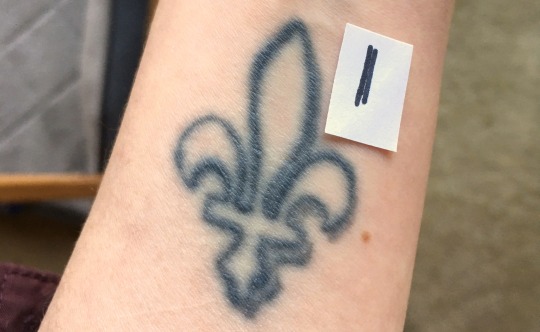
A 17-year-old tattoo in carbon black ink photographed with a swatch of black Sharpie on white printer paper.
The fact that charcoal-based tattoo inks continue to be used today, more than 5,000 years after the first charcoal tattoo was given, shows that charcoal is an effective, relatively safe tattoo pigment, unlike woad. Additionally, charcoal can be easily produced with wood fires, meaning it would have been a readily available material for tattoo artists in the early medieval British Isles. We would need more direct evidence, like a tattooed body from the British Isles, to confirm its use though.
As of June 2024, there have been at least 279 bog bodies* found in the British Isles (Ó Floinn 1995, Turner 1995, Cowie, Picken, Wallace 2011, Giles 2020, BBC 2024), a handful of which have made it into modern museum collections. Unfortunately, tattoos have not been found on any of them. (We don't have a full scientific analysis for the 2023 Bellaghy find yet though.)
*This number includes some finds from fens. It does not include the Cladh Hallan composite mummies.
Tattoos in period art?
It has been suggested that the man fight a beast on Book of Kells f. 130r may be naked and covered in tattoos (MacQuarrie 1997). However, Dress in Ireland author Mairead Dunlevy interprets this illustration as a man wearing a jacket and trews (Dunlevy 1989). Looking at some of the other figures in the Book of Kells, I agree with Dunlevy. F. 97v shows the same long, fitted sleeves and round neckline. F. 292r has long, fitted leg coverings, presumably trews, and also long sleeves. The interlace and dot motifs on f. 130r's legs may be embroidery. Embroidered garments were a status symbol in early medieval Ireland (Dunlevy 1989).

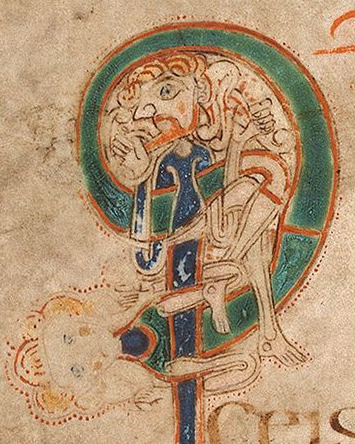
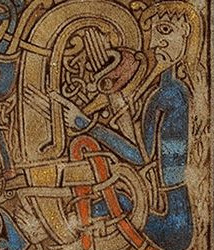
Left to right: Book of Kells folios 130r, 97v, 292r
A couple of sculptures in County Fermanagh might sport depictions of Irish tattoos. The first, known as the Bishop stone, is in the Killadeas cemetery. It features a carved head with 2 marks on the left side of the face, a double line beside the mouth and a single line below the eye. These lines may represent tattoos.
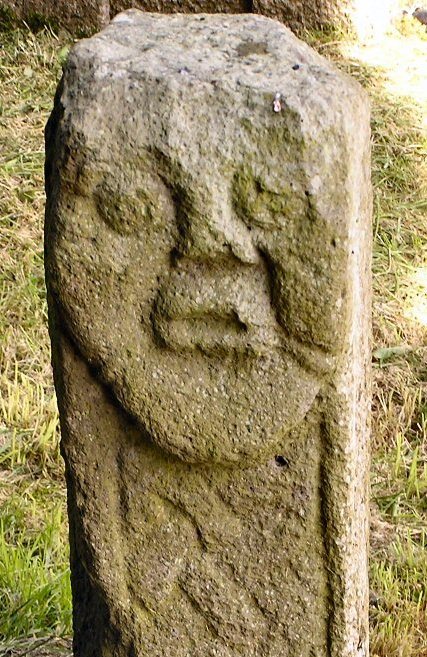

The second sculpture is the Janus figure on Boa Island. (So named because it has 2 faces; it's not Roman.) It has marks under the right eye and extending from the corner of the left eye that may be tattoos.
I cannot find a definitive date for the Bishop stone head, but it bears a strong resemblance to the nearby White Island church figures. The White Island figures are stylistically dated to the 9th-10th centuries and may come from a church that was destroyed by Vikings in 837 CE (Halpin and Newman 2006, Lowry-Corry 1959). The Janus figure is believed to be Iron Age or early medieval (Halpin and Newman 2006).
Conclusions:
Despite the fact that tattooing as a custom in the British Isles lasted for more than 500 years and was practiced by at least 3 different cultures, written sources remain our only solid evidence for it. With only a dozen sources, some of which probably copied each other, to cover this time span, there are huge gaps in our knowledge. The 4th century Picts may not have had the same tattoo designs, placements or reasons for getting tattooed as the 8th c. Irish or Anglo-Saxons. These sources only give us fragments of information on who got tattooed, where the tattoos were placed, what they looked like, how the tattoos were done, and why people got tattooed. Further complicating our limited information is the fact that most of the text sources come from foreigners and/or people who were prejudiced against tattooing, which calls their accuracy into question.
'The Cauldron of Posey' is one source that provides some detail while not showing prejudice against tattoos. The author of the poem was probably Christian, but the poem appears to have been written at a time when Pagan practices were still tolerated in Ireland. I have a complete translation of the poem along with a longer discussion of religious elements here.
Leave me a tip?
Bibliography:
BBC (2024). Bellaghy bog body: Human remains are 2,000 years old https://www.bbc.com/news/uk-northern-ireland-68092307
Breatnach, L. (1981). The Cauldron of Poesy. Ériu, 32(1981), 45-93. https://www.jstor.org/stable/30007454
Carey, J. (1997). The Three Things Required of a Poet. Ériu, 48(1997), 41-58. https://www.jstor.org/stable/30007956
Carr, Gillian. (2005). Woad, Tattooing and Identity in Later Iron Age and Early Roman Britain. Oxford Journal of Archaeology 24(3), 273–292. https://doi.org/10.1111/j.1468-0092.2005.00236.x
Cowie, T., Pickin, J. and Wallace, T. (2011). Bog bodies from Scotland: old finds, new records. Journal of Wetland Archaeology 10(1): 1–45.
Cunliffe, B. (1977) The Romano-British Village at Chalton, Hants. Proceedings of the Hampshire Field Club and Archaeological Society, 33(1977), 45-67.
Dunlevy, Mairead (1989). Dress in Ireland. B. T. Batsford LTD, London.
eDIL s.v. crechad https://dil.ie/12794
Giles, Melanie. (2020). Bog Bodies Face to face with the past. Manchester University Press, Manchester. https://library.oapen.org/viewer/web/viewer.html?file=/bitstream/handle/20.500.12657/46717/9781526150196_fullhl.pdf?sequence=1&isAllowed=y
Halpin, A., Newman, C. (2006). Ireland: An Oxford Archaeological Guide to Sites from Earliest Times to AD 1600. Oxford University Press, Oxford. https://archive.org/details/irelandoxfordarc0000halp/page/n3/mode/2up
Hoecherl, M. (2016). Controlling Colours: Function and Meaning of Colour in the British Iron Age. Archaeopress Publishing LTD, Oxford. https://www.google.com/books/edition/Controlling_Colours/WRteEAAAQBAJ?hl=en&gbpv=0
Lambert, S. K. (2004). The Problem of the Woad. Dunsgathan.net. https://dunsgathan.net/essays/woad.htm
Lowry-Corry, D. (1959). A Newly Discovered Statue at the Church on White Island, County Fermanagh. Ulster Journal of Archaeology, 22(1959), 59-66. https://www.jstor.org/stable/20567530
MacQuarrie, Charles. (1997). Insular Celtic tattooing: History, myth and metaphor. Etudes Celtiques, 33, 159-189. https://doi.org/10.3406/ecelt.1997.2117
McManus, D. (1988). Irish Letter-Names and Their Kennings. Ériu, 39(1988), 127-168. https://www.jstor.org/stable/30024135
Ó Floinn, R. (1995). Recent research into Irish bog bodies. In R. C. Turner and R. G. Scaife (eds) Bog Bodies: New Discoveries and New Perspectives (p. 137–45). British Museum Press, London. ISBN: 9780714123059
Pankova, S. (2013). One More Culture with Ancient Tattoo Tradition in Southern Siberia: Tattoos on a Mummy from the Oglakhty Burial Ground, 3rd-4th century AD. Zurich Studies in Archaeology, 9(2013), 75-86.
Samadelli, M., Melisc, M., Miccolic, M., Vigld, E.E., Zinka, A.R. (2015). Complete mapping of the tattoos of the 5300-year-old Tyrolean Iceman. Journal of Cultural Heritage, 16(2015), 753–758.
Story, Joanna (1995). Charlemagne and Northumbria : the in
fluence of Francia on Northumbrian politics in the later eighth and early ninth centuries. [Doctoral Thesis]. Durham University. http://etheses.dur.ac.uk/1460/
Szacillo, J. (2012). Irish hagiography and its dating: a study of the O'Donohue group of Irish saints' lives. [Doctoral Thesis]. Queen's University Belfast.
Turner, R.C. (1995). Resent Research into British Bog Bodies. In R. C. Turner and R. G. Scaife (eds) Bog Bodies: New Discoveries and New Perspectives (p. 221–34). British Museum Press, London. ISBN: 9780714123059
Ware, C. (2021). A Literary Commentary on Panegyrici Latini VI(7) An Oration Delivered Before the Emperor Constantine in Trier, ca. AD 310. Cambridge University Press, Cambridge. https://www.google.com/books/edition/A_Literary_Commentary_on_Panegyrici_Lati/oEwMEAAAQBAJ?hl=en&gbpv=0
#early medieval#roman era#pict#tattoos#ancient celts#apologies to people who wanted a shorter post#archaeology#art#anecdotes and observations#statutes and laws#irish history#gaelic ireland#medieval ireland#anglo saxon#insular celts#romano british
102 notes
·
View notes
Text
Maggie Smith, Oscar-winning star of stage and screen, dies aged 89 💔
Dame Maggie Smith, the masterful, scene-stealing actor who won an Oscar for the 1969 film “The Prime of Miss Jean Brodie” and gained new fans in the 21st century as the dowager Countess of Grantham in “ Downton Abbey” and Professor Minerva McGonagall in the Harry Potter films, died early Friday in a London hospital.
Margaret Natalie Smith was born in Ilford, on the eastern edge of London, on 28th December 1934. Her father was assigned in 1939 to wartime duty in Oxford, where her theatre studies at the Oxford Playhouse School led to a busy apprenticeship.
One of Smith’s most iconic early roles was as Desdemona in Shakespeare's Othello. Laurence Olivier spotted her talent, invited her to be part of his original National Theatre company and cast her as his co-star in a 1965 film adaptation of “Othello.”
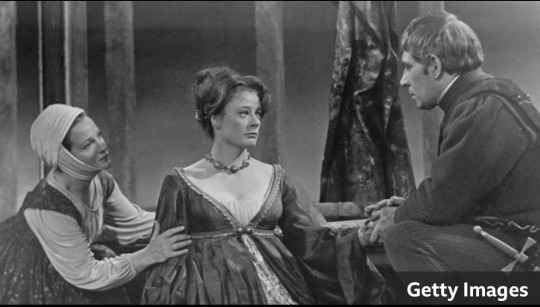
Laurence Olivier offered Smith the part opposite his Othello
Smith was frequently rated the preeminent British female performer of a generation with two Oscars, a clutch of Academy Award nominations and a shelf full of acting trophies.
The role that brought Smith international fame came in 1969 when she played the determined non-conformist teacher in the title role of The Prime of Miss Jean Brodie.
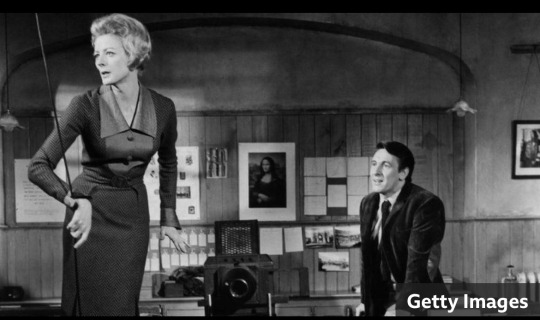
The role of Jean Brodie, alongside future husband Robert Stephens, won her an Oscar
The film was adapted from the 1961 novel by Muriel Spark, set in 1930s Edinburgh, and the character was based on the author's inspirational teacher.
"Jean Brodie," in which she played a dangerously charismatic Edinburgh schoolteacher, brought her the Academy Award for best actress, and the British Academy Film Award (BAFTA) as well.
Maggie Smith won critical acclaim for her role as Betsey Trotwood in a BBC adaptation of David Copperfield at the turn of the century. The part also brought her Bafta and Emmy nominations.

She appeared with a young Daniel Radcliffe in David Copperfield.
She starred alongside a young Daniel Radcliffe, who she would later act with again in the Harry Potter films.
In 2001, she took on the role of Professor Minerva McGonagall in Harry Potter and the Philosopher's Stone.

Dame Magie Smith is known to millions as Professor Minerva McGonagall from Harry Potter. Dame Maggie was reportedly the only actor JK Rowling specifically asked to star in the films.
In 2007, while working on Harry Potter and The Half-Blood Prince, Dame Maggie was diagnosed with breast cancer but continued filming. She was given the all-clear after two years of treatment.
From 2010, she was the acid-tongued Violet Crawley, Dowager Countess of Grantham, in the hit TV period drama “ Downton Abbey,” a role that won her legions of fans, three Emmy Awards, a Golden Globe and a host of other awards nominations.

Downton Abbey - Violet Crawley - The period ITV drama ran from 2001 to 2015, followed by two films
One of Smith's most famous later roles was as a homeless woman in The Lady In The Van, as Miss Shepherd, a redoubtable woman who lived for years in her vehicle on Bennett’s London driveway.

Smith first played Miss Shepherd on stage in 1999 and earned an Olivier nomination for Best Actress
Smith added a supporting actress Oscar for “California Suite” in 1978, Golden Globes for “California Suite” and “A Room with a View,” and BAFTAs for lead actress in “A Private Function” in 1984, “A Room with a View” in 1986, and “The Lonely Passion of Judith Hearne” in 1988.
She also received Academy Award nominations as a supporting actress in “Othello,” “Travels with My Aunt,” “Room with a View” and “Gosford Park,” and a BAFTA award for supporting actress in “Tea with Mussolini.” On stage, she won a Tony in 1990 for “Lettice and Lovage.”
She was one of a select group of actors to win the treble of big US awards, with two Oscars, four Emmys and a Tony - as well as seven Baftas and an honorary Olivier Award in the UK 🇬🇧
Maggie Smith was made a Dame Commander of the British Empire 🏅 the equivalent of a knight, in 1990.

She will never be forgotten & her characters will continue on, for future generations to love 💫 🎭
RIP Maggie Smith 1934-2024 🥀 🖤
#DameMaggieSmith #Oscar-winning #star #film #ThePrimeofMissJeanBrodie #DowntonAbbey #CountessofGrantham #VioletCrawley #BAFTA #HarryPotter #ProfessorMinervaMcGonagall TheLadyInTheVan #MissShepherd #GoldenGlobe #Gettyimages
Posted 27th September 2024
13 notes
·
View notes
Text
Bill Calhoun exists to pad out the parallels between Joshua and Edward by acting as a Friend From His Old Life, ala Daniel. And Daniel is a paternalistic wolf in sheep’s clothing who (unconsciously) wraps up his colonial exploits in themes of care and growth, offsetting Joshua’s open hostility. Daniel is also a character of color, albeit a mishandled one in an inappropriately racialized story. Bill tends to be depicted as black in fancontent, maybe because people pick up on that parallel. The key difference is that he exits the narrative as soon as the Legion is founded. So in my mind, it benefits to look at Bill’s characterization less as a coda to a pre-existing system of oppression, and more as an examination of the kind of person we expect to get involved in those systems, and the disastrous results that those expectations lead to. A bad victim, if you will - another member of the Followers who experienced a huge, violent trauma at a disturbingly early age, the same way Edward did, but unlike him is considered too unpleasant, burdensome, misguided and dangerous to be nurtured out of it. Someone who was never quite afforded the same amount of concern and grace as was given to blonde haired, square jawed, “gifted” young (white) men like his buddy. The soon-to-be dictator. Fun!
#and that’s why the angry young man trope is full of white people#cus all the angry young black men are dead.#legionposting#bill calhoun#edward sallow#fallout new vegas#thoughts#joshua graham#daniel fnv#Daniel#caesar’s legion
23 notes
·
View notes
Text





─ •✧ CATHERINE'S YEAR IN REVIEW : NOVEMBER ✧• ─
1 NOVEMBER - Catherine visited Dadvengers. She was later spotted at Prince George's Football Game. 2 NOVEMBER - The Duchess of Rothesay and The Duke were received by His Majesty's Lord-Lieutenant of Moray (Major General the Hon. Seymour Monro) at Burghead Primary School. Afterwards, they visited Brodieshill Farm. Subsequently William and Catherine visited Day1 and were received by His Majesty's Lord-Lieutenant of Inverness (Mr. James Wotherspoon). 8 NOVEMBER - Catherine visited the 1st The Queen's Dragoon Guards Regiment at Robertson Barracks as their Colonel-in-Chief. 11 NOVEMBER - Catherine and William attended the Royal British Legion Festival of Remembrance at Royal Albert Hall. 12 NOVEMBER - The Princess of Wales along with Prince William and other members of the Royal Family attended the Remembrance Day Service of Remembrance at the Cenotaph. The broadcast of the 2023 Earthsot Awards, featured a video of Catherine and William snorkelling with Coral Vita in The Bahamas from their tour. 14 NOVEMBER - Catherine received Mr. Jack Shonkoff (Director, Center on the Developing Child, Harvard University) at Windsor Castle. In the evening, she attended a Shaping Us National Symposium Reception at the Design Museum. Finally, Catherine and William attended King Charles's Private Birthday Party at Clarence House. 15 NOVEMBER - Catherine held a Symposium on Early Childhood at the Design Museum. 16 NOVEMBER - She held a Meeting at Windsor Castle. 17 NOVEMBER - Catherine appeared in a video message to open BBC's Children In Need. 18 NOVEMBER - Kensington Palace released a new photograph featuring Catherine decorating a Christmas Tree to announce the 'Together At Christmas' Carol Concert. 21 NOVEMBER - Catherine and William welcomed The President of the Republic of Korea and Mrs Kim Keon Hee at the Four Seasons Hotel. They then accompanied the Presidential Couple to Horse Guards and were met by The King and Queen for the official welcome ceremony. Afterwards, they viewed an Exhibition of the Royal Collection items relating to the Republic of Korea. Finally, they attended the State Banquet thrown in the honour of the President and First Lady at Buckingham Palace. 22 NOVEMBER - Catherine and William held a Reception at Windsor Castle. 24 NOVEMBER - She was received by Mr. Martin Russell (Deputy Lieutenant of Greater London) at Sebby's Corner in Barnet. 30 NOVEMBER - Catherine and William received Crown Princess Victoria of Sweden and Prince Daniel of Sweden at Windsor Castle. Afterwards, they were we're joined by Victoria and Daniel for the Royal Variety Performance.
#british royal family#british royals#royalty#royals#royal#catherine middleton#kate middleton#brf#british royalty#duchess of cambridge#catherine review : november#year in review 2023 : catherine#year in review : catherine#review november#year in review : 2023#review 2023#royaltyedit#royalty edit#princess of wales#the princess of wales#princess catherine#princess kate#catherine princess of wales#prince william#william prince of wales#prince of wales#the prince of wales#my edit#my photoset
40 notes
·
View notes
Photo

Banastre Tarleton
Banastre Tarleton (1754-1833) was a British military officer and politician, most famous for his role in the southern campaigns of the American Revolutionary War (1775-1783). In command of an elite unit of Loyalists called the British Legion, Tarleton gained a reputation for aggression and cruelty, with Patriots even coining the phrase 'Tarleton's Quarter' to refer to his mercilessness.
Tarleton joined the British Army in April 1775 at age 20 after blowing through his inheritance. Sent overseas to fight the American rebels, he soon became one of the most infamous British officers of the conflict. Called 'Bloody Ban' after his men massacred surrendering American soldiers at the Battle of Waxhaws, Tarleton led his British Legion on raids throughout the American South, their plumed leather helmets and green jackets striking fear into the hearts of many Patriots. Defeated by Daniel Morgan at the Battle of Cowpens (17 January 1781), Tarleton nevertheless managed to return to England after the war with his reputation intact. He began a long political career in Parliament, in which he notably defended the slave trade, before his death on 15 January 1833 at the age of 78. He is best remembered today for his ruthlessness during the war, although many tales of his cruelty have been exaggerated.
Early Life
Banastre Tarleton was born in Liverpool, England, on 21 August 1754, the third of seven children born to John Tarleton and his wife Jane Parker. John Tarleton was a successful businessman involved in the Caribbean sugar trade and owned plantations in Jamaica, Curaçao, and several other islands in the West Indies. By the 1760s, the elder Tarleton owned three ships that were primarily used to deliver enslaved Africans to Jamaica; indeed, much of the Tarleton family's wealth was derived from the slave trade. In 1764, John Tarleton (or 'Great T' as he was called by his constituents) was elected mayor of Liverpool and served a single one-year term. In 1768, the elder Tarleton tried to stand for election to Parliament, but a mob of whalers prevented him from running.
Banastre (or Ban, as he preferred to be called) attended school in Liverpool. Intelligent, handsome, and charming, he was not a diligent student, preferring to spend his time playing cricket; despite his small physique, he was surprisingly strong and enjoyed many other athletic activities like boxing, horseback riding, and tennis. In the autumn of 1771, Ban and his older brother Thomas were sent to Oxford to study at University College. Tarleton remained there until 6 September 1773, when his father unexpectedly died, leaving him an inheritance of £5,000. With this small fortune, Tarleton headed to London to begin studying law at the Middle Temple. His studiousness had not much improved, however, as Tarleton often neglected his studies in favor of attending the theatre or drinking and gambling at the fashionable Cocoa Tree club. It was not long before he had nearly exhausted his inheritance, forcing him to drop out of law school.
During this period of adolescent partying, the wayward Tarleton befriended several British army officers, who likely helped put his thoughts on a military path. On 20 April 1775, the 20-year-old Tarleton purchased a cornet's commission in the King's Dragoon Guards, one of the most prestigious regiments in the entire army. It was an interesting time to enter military service, as only the day before, the Battles of Lexington and Concord had been fought on the other side of the Atlantic in the British colony of Massachusetts, sparking the American Revolution. After several months of intensive training, Cornet Tarleton was finally sent to North America in February 1776, setting sail from Cork, Ireland, under the command of Lord Charles Cornwallis. Little did Tarleton know that by the time his service in the New World was over, he would be regarded as one of the most infamous men in America.
Continue reading...
11 notes
·
View notes
Text
Fallout Casting for Satoru "Kakashi-sensei" Gojojojo for Jujutsu Kaisen Abridged react fic

"Five bucks and I'll tongue punch your fart box." - Satoru Gojo, Episode 3 JJK Abridged (by The Schmuck Squad).

Reasons To Why I Believe These Characters Should Be Cast As The Variant of JJK Abridge's Satoru Gojo are listed below the cut:
Elrand Brandt (Fallout Vault Dweller OC, faceclaim Jason Statham) -> In his twenties and had told the Master to kill himself.
Finidy Mona (Fallout 2 Chosen One OC, faceclaim Jessica Alba) -> "Chosen One" will be as close to "Honored One" as Fallout will get.
Alph Dolen (Fallout 3 Lone Wanderer OC, faceclaim Sam Blackensee. Has transformed into a Ghoul) -> Fawkes talked about how it was his destiny to save Project Purity and his hopes and dreams died in his early twenties.
Raul Alfonso Tejada (a ghoul mechanic that helps out Ryder in Fallout New Vegas, follows her around after she saved him on Black Mountain and is inspired to pick up his guns again to protect those of lesser fortune) -> He's badass and voiced by Danny Trejo. Also got very father-figure vibes going on. And lost a young female companion (his sister) like Gojo had (Riko) whom they were both trying to protect.
Nate Gust Sarid (Fallout 4 Sole Survivor OC, faceclaim Steven He. He is a Synthetic Human) -> The SPECIAL cheat stats make a lot more sense with him given the context that he's a synth, which could be similar to Gojo's cheat skills in general. Not to mention they're both (basically) fathers (Shaun for Nate and Yuji & Megumi for Gojo).
Vega (Fallout 76 Resident OC, faceclaim Yvonne Strahovski. Has transformed into a Super Mutant) -> Both are selfish and have unbreakable egos.
Tycho (from Fallout, a Nevada ranger who's wandered the Wasteland of California, he helps Elrand beat Gizmo and takes on the Master's Super Mutant army) -> Hides his face and a total all around badass.
Roger Westin (from Fallout 2, an NCR congressman fighting against the corruption within the New California Republic with underhanded tactics to build a peaceful, civil expansion into the north) -> Badass breaking the rules to do the right thing.
Butch DeLoria (from Fallout 3, Alph's former childhood bully in Vault 101, now one of his closest allies after the Lone Wanderer saved the life of Butch's mother from Radroaches. After Alph and Amata we're run out of the Vault, Butch helped build up the rebellion against Overseer Almodovar, and had managed to slip out of the vault to get Alph and Amata's help. After resolving the issue, Butch joined up with Alph and Amata to wander the Capital Wasteland, becoming the founding members of the newest Tunnel Snakes) -> He's rocking a style and while he can come off as a jerk, he's got a heart of gold, though never a push-over.
Joshua Graham (from Fallout New Vegas' Honest Hearts DLC, Joshua is Caesar's former Legate, now known as "the Burned Man", he resides in Zion to help the Dead Horses (as well as Daniel and the Sorrows) against the threat of the White Legs. Ryder gets some very important insight from him on how to deal with Caesar's Legion) -> Okay, so his eyes aren't blindfolded, but he is bandaged up elsewhere. And not to mention his voice is captivating. And he'd probably despise his Gojo variant which makes for some humorous opportunities.
Deacon (from Fallout 4, the Railroad's top intelligence agent and overall the best spymaster you'll ever meet, he trains Nate in the art of espionage and being a better liar. Had given Nate trust issues for a while when partnered together. He also helps Nate discover he is a synth and come to terms with his newfound existence) -> He's got the charisma. He's got the sunglasses. He's got the lies and the confidence. He's got the vibe of a responsible irresponsible adult. He's got the vibes of a back-alley drug dealer guaranteed to give you the good stuff and be there with you to make sure it goes alright. He's probably stolen caps from Carrington. He's the man. The goat. The guy the Railroad keep around because he's really good at his job even if his tactics are questionable sometimes.
Remember, for the alternative option, REBLOG and put in the tags WHO else from the Fallout franchise should be Abridged!Gojo and WHY you think they'd better suit the role.
I've also created and will continue to update (until the polling is done) a Master List for the poll results of the casted winners. You can find it right here.
You can find my Fallout OC profiles Master List right here, which also includes a link to the original post where I pitched my react fic idea. Anyway, hope you enjoyed, chow!
#fallout#jujutsu kaisen abridged#casting#react fic#polls#satoru gojo#the vault dweller#oc: elrand brandt#fallout 2#the chosen one#oc: finidy mona#fallout 3#the lone wanderer#oc: alph dolen#fallout new vegas#raul alfonso tejada#fallout 4#the sole survivor#oc: nate gust sarid#fallout 76#the resident#oc: vega#fallout tycho#tycho#roger westin#butch deloria#joshua graham#fo4 deacon#deacon#again must reiterate the alternative option means you REBLOG and put in the tags WHO you want from fallout to be casted and explain WHY
11 notes
·
View notes
Text




The Princess of Wales’ Year in Review: November
November 1st - The Princess of Wales, Joint Patron of the Royal Foundation of The Prince and Princess of Wales, visited Dadvengers November 2nd - The Duke and Duchess of Rothesay visited Outfit Moray, Burghead Primary School. Afterwards, they visited Brodieshill Farm, before finally visiting Day1 at Inverness Kart Raceway November 8th - The Princess of Wales, Colonel-in-Chief of 1st The Queen's Dragoon Guards, visited the Regiment at Robertson Barracks November 11th - The Prince and Princess of Wales were present with the King and Queen at the Royal British Legion Festival of Remembrance at the Royal Albert Hall November 12th - The Princess of Wales joined members of the Royal Family at the cenotaph for the Remembrance Sunday service. During the 2023 Earthshot Prize ceremony, a video of the Prince and Princess of Wales snorkelling in the Bahamas with Coral Vita was released November 14th - The Princess of Wales, Joint Patron of the Royal Foundation, received Mr. Jack Shonkoff (Director of Center on the Developing Child at Harvard University) at Windsor Castle. That evening, Catherine attended a reception at the Design Museum. Afterwards, the Prince and Princess of Wales joined members of the Royal Family at a private birthday party for the King November 15th - The Princess of Wales, Joint Patron of the Royal Foundation, held a symposium on Early Childhood at the Design Museum November 16th - The Princess of Wales, Joint Patron of the Royal Foundation, held a meeting at Windsor Castle. The Royal Foundation of The Prince and Princess of Wales and Mayor of Greater Manchester announced £100,000 funding to support the work of the Manchester Peace Together Alliance to provide positive opportunities for young people and reduce youth violence November 17th - The Princess of Wales opened BBC's Children In Need with a message about the importance of childhood November 18th - A photo of the Princess of Wales decorating a christmas tree was released to announce her carol concert November 21st - The Prince and Princess of Wales welcomed The President of the Republic of Korea and Mrs Kim Keon Hee on behalf of The King at the Four Seasons Hotel. They then drove to Horse Guards and were met by The King and Queen. At Buckingham Palace, they viewed an exhibit of South Korean art from the Royal Collection. Finally, they attended a State Banquet at Buckingham Palace November 22nd - The Prince and Princess of Wales, Joint Patrons of the Royal Foundation of The Prince and Princess of Wales, held a reception at Windsor Castle November 24th - The Princess of Wales, Joint Patron of the Royal Foundation, visited Sebby's Corner November 30th - The Prince and Princess of Wales received Crown Princess Victoria and Prince Daniel of Sweden at Windsor Castle. That evening, the four royals attended the Royal Variety Performance in aid of the Royal Variety Charity at the Royal Albert Hall
#mine#royaltyedit#kate#yearreview#dadvengers#scotland23: outfit moray#scotland23: brodieshill farm#scotland23: day1#festival of remembrance 23#rd 23#jack shonkoff 23#design museum reception 23#charles75#ey symposium 23#meeting23 5#children in need 23#south korea state visit: arrival#south korea state visit: horse guards#south korea state visit: banquet#rf reception 23#sebbys corner 23#vd meeting 23#rvp 23
19 notes
·
View notes
Text

Pacifism
Thou shalt not kill was a religious command, and pacifism began as a religious or quasi-religious doctrine. The condemnation of individual retaliation appears in most “higher” religions and philosophies — so that the submissive non-resistance of Christianity is closely analogous to the non-violence of Indian religion, the non-assertion of Chinese Taoism, and the defiant non-resistance of Socrates and many of his successors. The power of non-violence over violence, of apparent weakness over apparent strength, of right over might, is illustrated in every mythology — Jack the Giant-Killer, David and Goliath and Daniel in the Lions’ Den, Rama and Ravan and Gautama and Mara, the Battle of Marathon or the Battle of Britain, Horatius on the Bridge or the schoolboy’s voice saying Play up, play up, mid play the game, or Thurber’s Termite. The difference is that Jesus and Gautama and Mahavira and Lao-tse and Socrates have ordered non-retaliation as a moral imperative rather than merely pointing it as a moral to a story. But it was only individual non-retaliation — the State still had to punish offenders at home and fight enemies abroad. And there were several personal inconsistencies — Jesus told us not to resist evil, but he drove the money-changers from the Temple by force; Socrates would not resist the Athenian state, but he fought bravely enough in the Athenian army; Marcus Aurelius as a philosopher was a convinced Stoic, but as a Roman Emperor he persecuted Christians and fought barbarians vigorously; Asoka was converted to Buddhism and renounced war, but he kept his conquests and ruled as firmly as ever.
The contradiction between the known wrongness and the continued use of violence has usually been rationalised by the assertion that life in this world is either evil or illusory, so that either you have to do bad things for good reasons or else it doesn’t really matter what you do anyway. Followers of theoretically non-violent systems have in practice tended to make life tolerable by treating the more difficult doctrines as counsels of perfection or to withdraw from it into asceticism or quietism or both. This tendency is of course greatly reinforced when a religion or philosophy becomes established by the State. “Every Church,” said Tolstoy, “excludes the doctrine of Christ.” The story of pacifism is ini fact the story of the way monks and heretics preserved the doctrine of Christ despite its rejection by the Churches.
The early Christians, who were heretics themselves, often took non-resistance seriously. It is well known that many of them refused to sacrifice to the Roman gods and were martyred; it is less well known that many of them similarly refused to bear arms in the Roman legions and were also martyred. Many writers, such as Origen and Lactantius, made uncomplimentary remarks about war; Tertullian’s De Corona condemned it out of hand. The change came at the beginning of the 4th century, naturally enough, when Christianity was made the state religion of the Roman Empire— when, according to the Spanish humanist, Luis Vives, “Constantine entered the house of Christ with the Devil by his side.” This was when the revolting doctrine of the “just war” was invented, though to see it at its best you must read Augustine or Aquinas, The Czech theologian, Petr Chelcicky wrote a book called The Net of Faith (1521), which described how the net had been strong enough to hold little fish like the early Christians but was broken by big fish like Constantine, so that they nearly all got away. But not quite all. The doctrine of non-resistance was held by early heretical sects like the Montanists and Marcionists, and later ones like the Albigenses and Waldenses always tended to condemn war (and, as often as not, the Warfare State as well). The same was true of 16th century humanists like Erasmus and Vives. But modern pacifism began with the followers of Wyclif, the Lollards, and of Hus. When the extreme Hussites—Taborites— were routed in 1434 by their moderate enemies— Calixtines— after twenty years of bitter war, the survivors became non-resistants under their new name of Bohemian Brethren; the Moravians were a later branch who emigrated to America. Many “anabaptist” (i.e. extreme Protestant) sects followed the same pattern of pacifism following disaster after the fall of Minister in 1535. The Dutch Mennonites and Collegiants, the German Schwenkfelders and Dunkers, and the English Brownists and Baptists, were only a few of the unknown number of anabaptist sects who turned towards anarchist pacifism in the 16th and 17th centuries, when it became clear that the Kingdom of Heaven was not of this world.
But the best known of all the peace sects is the Society of Friends* which has been chiefly responsible for keeping Christian pacifism alive during the last three hundred years. There have been many later sects —the French Camisards, the Russian Molokans and Dukhobors, the AngloAmerican Shakers, Christadelphians, Seventh Day Adventists and Jehovah’s Witnesses— but the Quakers have had the greatest influence, because they have taken the maximum part in conventional life with the minimum compromise of their principles, and because they have been so much more tolerant than most other religious groups. The Quaker “peace testimony” appeared as early as George Fox’s reply to Cromwell’s Army Commissioners in 1651 and James Naylor’s last words in 1660, and it was formally stated in the ofl&cial declaration of the Society in January 1661 : “We certainly know and do testify to the world that the spirit of Christ, which leads us into all truth, will never move us to fight and war against any man with outward weapons, neither for the Kingdom of Christ nor for the kingdoms of this world .. When we have been wronged we have not sought to revenge ourselves. Never shall we lift up hand against any that thus use us, but desire the Lord may have mercy upon them, that they may consider what they have done.” This is a perfect formulation of the doctrine of non-resistance (and is exactly what Winstanley had been saying ten years earlier — how many disappointed Diggers became Quakers?). The remarkable thing is that the Quakers have never wavered from their first position.[2] Penn’s “Holy Experiment” of Pennsylvania was from its foundation in 1682 to the fall of the Quaker regime in 1756 the nearest to a non-violent state in history. Robert Barclay said in his Apologia (1676): “It is not lawful for Christians to resist evil or to war or fight in any cause.” Johnathan Dymond said in his Essay on War (1829): “Either we must refuse to fight or we must abandon Christianity.” This is still the Quaker view, and Quakers have always taken the lead in both the official peace movement and the unofficial pacifist movement. When A. C. F. Beales set out to write his History of Peace (1931), he was “surprised to find that every single idea current today about peace and war was being preached by organised bodies over a century ago, and that the world-wide ramifications of the presentday peace movement can be traced back in unbroken continuity to a handful of forgotten Quakers in England and America at the close of the Napoleonic Wars.” Thus it was quaker initiative that led to the formation of the British Peace Society in 1816 and of the National Peace Council in 1905, and Quakers have always been active in warrelief work (which has twice won them the Nobel Peace Prize). More important, it was Quakers who bore the brunt of resistance to the demands of the Militia Acts between 1757 and 1860, both by public protest and by individual conscientious objection. So they tried to prevent war happening and resisted when it did.
The point is that Quakers don’t actually follow the doctrine of non-resistance at all. Fox told Cromwell in 1654, “My weapons are not carnal but spiritual,” but they were highly effective weapons for all that. (“The armed prophet triumphs,” said Machiavelli, “the unarmed prophet perishes.” Fox’s soul goes marching on, but where is Cromwell’s?) Quakers have never been reluctant to protest against social injustice. Elizabeth Fry’s prison work is hardly “non-resistance”. It was Quakers who led the campaign against slavery, from the early protest of the German Friends in Pennsylvania in 1688 to the formation of the Society for the Abolition of the Slave Trade in 1787, and right on to the end. In fact one of the most interesting things in the history of modern dissent is the close connection between professed nonresistance to evil and sustained resistance to racial oppression. William Lloyd Garrison, the American Abolitionist leader, wasn’t a Quaker because he wasn’t a Christian, but he was a total non-resistant, and so were many of his colleagues — such as Whittier, Ballou and Musser. Indeed he symbolises in his own career this curious connection, for he was not only the founder of the New England and American AntiSlavery Societies and editor of the Liberator but also the founder of the New England Non-Resistance Society and editor of the NonResistor,
One day it might be worth making a detailed examination of the Boston Peace Convention of 1838, where the Non-Resistance Societywas formed. It passed a resolution “that no man, no government, has a right to take the life of man, on any pretext, according to the gospel of Christ,” and issued a Declaration of Sentiments, including the following: “We cannot acknowledge allegiance to any human government . , . Our country is the world, our countrymen are all mankind [this was the motto of the Liberator] ... We repudiate all human politics, worldly honours and stations of authority ... We cordially adopt the nonresistance principle.” Here is pure Christian anarchism, derived from 17th century Puritanism— no wonder it excited Tolstoy so much. But these gentle unworldly pacifists were right in the front of the campaign against slavery, and Garrison was notorious for his language about the American slave-owners, which was no less violent than Bertrand Russell’s about the present rulers of the world. Non-resistance indeed!
The fact is that theoretical non-resistance only means non-resistance in practice when it remains silent. The mere declaration of conscientious objection to violence is a form of resistance, since it involves nonco-operation with the State’s key functions of oppression and war. The State can tolerate the abolition of slavery, but not the abolition of war as well. When Jesus abrogated the traditional talion law he was unwittingly challenging his State. When Dymond said in 1826, “Now is the time for anti-slavery exertion; the time will come for anti-war exertion,” he was similarly threatening his State and ours. As Bourne said in 1918, “We cannot crusade against war without crusading implicitly against the State.” It is because most pacifists never realise this that they are constantly surprised by the hostility their behavour provokes. Most pacifists are really sentimentalists— hoping to get rid of war without changing anything else, so you can bully people as long as you don’t actually kill them. It was because the greatest of all pacifists— Tolstoy— saw through this sentimentalism that he became an anarchist after 1878 as well as a pacifist. He never called himself one, since he used the word to describe those who relied on violence, but his eloquent and unequivocal condemnation of the State makes him one of the greatest of all anarchists too. His remark that “the most frightful robber-band is not as frightful as the State,” is simply an echo from Augustine’s City of God without Augustine’s pious reservation: “Without justice, what are States but great robber-bands.” And because Tolstoy utterly denied the justice of the State’s authority, he had to proclaim the duty of total resistance to the State’s totalitarian demands. It is ironical that he derived the right of resistance to the State from the same source that Augustine derived the right of oppression by the State— God.
“The clear and simple question is that,” he said in his Letter to the Russian Conscientious Objectors (1909): “Which law do you consider to be binding for yourself—the law of God, which is your conscience; or the law of man, which is the State?” The answer is in no doubt. “Do not resist evil,” he said in his Letter to a Hindu (1908), “but do not participate in evil either.” The doctrine is non-resistance, but the implication is obstinate resistance. He had already said in his Letter to the Swedish Peace Party (1899): “Those in power neither can nor will abolish their armies.” And the solution? “The people must take the matter into their own hands.” Here we see how religious pacifism and political anti-militarism came to the same conclusion before the Great War, for what Tolstoy was advocating was in fact a non-violent general strike, individual civil disobedience on such a scale that it became direct action, a revolutionary technique similar to those proposed by William Godwin, Pierre Proudhon and Benjamin Tucker, an anarcho-syndicalist insurrection without the insistence on violence that disfigured the thought of Bakunin, Kropotkin and Malatesta. But how can such a strike be organised? In the event the pacifists were shown to suffer from the same false optimism as the anti-militarists, for when the Great War came their non- violent general strike turned out to be just as much of a myth as the industrial; general strike; and they were reduced to individual conscientious objection when they were called up.
It is often thought that military conscription was unknown in this country until the Great War, but as well as the old Militia Acts there were the press-gangs and the most efficient recruiting sergeant of all, hunger; Professor Coulton’s reference to “hunger-conscripts under the name of volunteers” was no exaggeration, and it was hunger that kept the British Army going until war became too professional and too efficient in killing people. Conscription in its modern form appeared on the horizon only when the weakness of British military preparations was revealed by the Boer War (the first serious war for half a century), and the foundation of the National Service League in 1902 began a long campaign for compulsory military service. Even when the Great War came the Government delayed as long as possible, hoping that Alfred Leete’s picture of Kitchener saying Your Country needs You would be enough. But within the first year the failure of voluntary recruiting led to National Registration (of all men and women between 15 and 75!), and this showed that two million men of military age had decided not to fight for their King and Country. After this the process was fairly rapid, with “attestation” in October 1915, conscription for single men in January and married men in May 1916, and further extensions in March and May 1917 and again in January and April 1918. Conscription didn’t come to an end until August 1921.[3]
Nothing is more instructive than the way the leaders of the Labour Movement rejected every stage in this process before it happened and then accepted it afterwards, condemning the principle of conscription all the time they were collaborating with it. In the same way they managed between the Wars to oppose pacifism and unilateral disarmament on one side and conscription and rearmament on the other, and once again they accepted the fact of conscription when it returned in April 1939; after the last War, of course, it was the Labour Government that extended conscription in 1947 and also decided to manufacture and test the British Bomb. All with the best intentions. In much the same way the Official peace movement — the conference and arbitration people — which had been trying to build igloos in the Sahara for a century, collapsed as ignominiously as the Second International in 1914 and offered even less resistance in 1939. On both occasions the only people who stood firmly and unwaveringly against all war were the extreme pacifists and the extreme socialists (including many anarchists). Here we come up against the really crucial problem, which consists of two questions — Who are the real war-resisters? and How can the warresisters really resist war?
The answer to the first question was given in the Great War, when the Labour and peace movements utterly failed to resist, when the “conscientious objectors” were found to have political as well as religious principles, when the people who formed the No Conscription Fellowship in November 1914 and began going to jail just over a year later turned out to be mostly Quakers and members of the ILP. Real pacifism and real anti-militarism were the same thing, though some people followed one rather than the other, since they persuaded the same end by the same means. Religious people had to have political feelings to make the public protest, and political people had to have religious feelings to take the punishment. Remember how unpleasant it was to be a “conchie” in the Great War.
It is estimated that 6,000 men went to prison, and the common sentence was two years; worse, you could be arrested immediately after release ,if they wanted to play cat-and-mouse with you. More than 650 people were imprisoned twice, and three were actually put inside six times. Arthur Creech Jones, later a Labour Colonial Secretary, was sentenced in succession to 6 months, 12 months, 2 years and 2 years again; Fenner Brockway, founder of the NCF and later of the Movement for Colonial Freedom, got 6 months, 12 months and 2 years. (Notice how both of them were strong anti-racialists as well as anti-militarists.) At least 34 men were taken over to France in May 1916 and sentenced to be shot, though Asquith stopped any of the sentences being carried out; and more than twice that number died as a direct result of brutal treatment they received in custody, which was quite normal. It is a valid criticism of individual passive resistance to war to point out that it is ineffective, but critics must admit that it demanded considerable courage and determination. The obvious corollary is that this determination should somehow be employed more effectively, and the obvious hope between the Wars was that it would be properly organised.
But that hope was false. The NCF was dissolved in November 1919, though it was revived in February 1921 as the No More Wat Movement; in February 1937 this was absorbed by the Peace Pledge Union, which had been formed after Dick Sheppard’s famous letter of October 1934. (It is odd how Arthur Ponsonby’s similar declaration of December 1927 has been forgotten, while the Peace Pledge has become part of the national memory, along with the irrelevant Peace Ballot of 1934–35 and the unimportant Oxford Union resolution of February 1933). The result was in effect to dissolve the alliance between the religious and the political war-resisters, and this couldn’t be restored by the War Resisters’ International (which was formed in Holland in 1921) because its British section was the predominantly religious PPU. It is true that the PPU kept the faith alive and got well over 100,000 members by 1939, but it was passivist as well as pacifist, and when the war against Fascism came and thousands of men broke their pledges, it was reduced to publishing literature and counting up the numbers of COs in the registrations (seldom more than 2% and usually less than 1%). So after 1945 the situation was far more hopeless than it had been before 1914, because the war-resisters had failed miserably twice-over, and far more urgent too, because the Bomb meant that the next war really would be the war to end war, and everything else with it. The first question had been answered, but there was stili no answer to the second one — How can war-resisters really resist war? Perhaps it was just because everything had become so hopeless and so urgent that the answer came at last
#pacifism#direct action#community building#practical anarchy#practical anarchism#anarchist society#practical#revolution#anarchism#daily posts#communism#anti capitalist#anti capitalism#late stage capitalism#organization#grassroots#grass roots#anarchists#libraries#leftism#social issues#economy#economics#climate change#climate crisis#climate#ecology#anarchy works#environmentalism#environment
5 notes
·
View notes
Text
Bloody Valentines
Fandom: DC Comics, Batfam, Young Justice 98, Titans, GL Corps, Legion of Super Heroes, Flashfam, New Gods
Summary: 90s vampire slasher AU
Chapters: 5/?
Characters: Dick Grayson, Joseph Wilson, Jason Todd, Charley Parker, Zatanna, Eddie Bloomberg, Daniel Cassidy, Chester Williams DC, Guy Gardner, Kyle Rayner, Lilith Clay, Raven Roth, Kole Weathers, Bette Kane, Donna Troy, Roy Harper, Jenni Ognats, Bart Allen, Virgil Hawkins, Richie Foley, Ayla Ranzz, Zoe Saugin, Rol Purtha, Darla Aquista, Lori Zechlin, Hal Jordan, Helen Jordan II, Orion DC, Lightray DC
Relationships: DickJoey, Daniel Cassidy/Zatanna, DonnaRoy, Jenni Ognats/Virgil Hawkins, Raven/Lilith Clay
Additional Tags: POV First Person, Unreliable Narrator(s), Vampires, No Capes AU, 90s Slasher AU, Homoeroticism, Horror, Slasher
Chapter Five: The Omen (Lilith's POV)
Donna suggested the trip, and Roy insisted on driving us. I invited Bette and Kole, and Donna requested Raven join us. It was the only time we all had off to vacation. We planned on spelunking and walking the beach and doing all sorts of things, but the closer the trip got, the more we all started feeling uneasy. Raven read a book, Bette nibbled on trail mix, Donna messed around with the map, Roy ignored her directions, and Kole slept soundly on my shoulder. Occasionally, I'd lean over and glance at Raven's book or check if Kole was alright, but the car was mostly silent.
Roy stopped in the middle of the road, and everyone looked up. "Injured animal in the road... Hold on," Roy whispered. He rolled the window down partway. "Hey! Do you need-?"
"No, thanks! Can you get around?" a man yelled, and Roy answered back before driving around them. Raven grabbed my wrist.
"Did you feel that?" Raven questioned. I shushed her. Where she came from, those feelings weren't as foreign to normal people. But yeah, I felt it. A full-body cold started in my frontal lobe and penetrated my scalp, trickling down my neck, shoulders, and chest like ice water. Fear. Primal. Final. It was different than regular fear. It was dreadful, helpless, hopeless. That was a fear, unlike anything I'd ever felt before.
"Mhm," I mumbled.
Raven and I felt things. Other people's feelings, the feelings of animals, and sometimes places. Empaths. Raven was more in tune with it than I was, but it came at a cost for both of us. She was heavily affected by the emotions of others, and it showed on her face all the time. I could mask it, but she never had to. Donna touched Roy's arm for Roy's comfort. Not hers. I could feel his distress.
He sighed. "Call me superstitious, but I've only seen a dead coyote a few times before, and nothing good ever comes from it... And that coyote isn't gonna make it. Looks like something ate it up," Roy stated. Donna whispered in his ear, and he shook his head.
The car fell silent until we reached Happy Harbor. I woke Kole, and we walked in the dark to our cabin. Raven had a dizzy spell as soon as we walked in, and I reached out to help her, but I felt it too. Bette grabbed me, Kole grabbed Raven, and they sat us down. "Yikes, you guys good?" Bette questioned. Raven and I nodded. The energy there was outrageous. Raven's hand brushed mine, and I saw a flash of Bette covered in blood and screaming. I recoiled. Raven stood up and took a deep breath.
"Let's go make s'mores while it's still early," Raven suggested. Everyone eased up, and we grabbed our jackets and the bag of roasting sticks and walked to the beach. Roy and Donna lagged behind, so we couldn't see them holding hands. We all knew about them, but they were worried about being labeled as an item and messing up their friendship. I didn't have to be an empath to see it wouldn't last.
When we got to the beach, a girl and her three male friends had already started a bonfire, so we shared our s'mores. They were calm and collected, so it helped everyone else relax. Then, a brunette and a redhead with a bowl cut came to the beach with hot dogs, and the brown-haired guy made a pass at me. Bette lied and told him it was a gay beach, but I don't think she had to lie to this one to leave me alone. He looked like the type of guy that was more than willing to take no for an answer and move on. I could feel the grief coming off his body, so I could've let him down without hurting his feelings.
We were at the beach until it got too cold to be outside. Once we returned to the cabin, we divvied up rooms and beds. Three rooms. Three beds. Bette and Kole wanted to stay up and paint each other's nails, so they bunked together. I asked Raven to stay with me, so Roy and Donna wouldn't have to find a way to lie to be together. The worst kept secret in America. Roy took his jacket off, and I glanced at his tattoo. Roy met eyes with me, and I leaned forward. I wanted to get a closer look and get a laugh from him. "Can I help you?" Roy laughed.
"Just getting a look at the details," I replied.
Roy nodded, and everyone got ready to take their showers. First, Roy, then Donna, Raven, Bette, Kole, and finally me. I didn't mind. I climbed into bed with Raven, and she turned to me. "What did you see?" Raven asked.
"You first," I whispered.
"I think Kole is going to kill someone," Raven whispered. I knit my brows.
"I think Bette's gonna kill somebody," I replied, "Maybe we should talk about something else..."
Raven looked at me, and we held eye contact for what felt like forever. "Do you think it'd be the same?" Raven questioned. I took a breath. I knew what she meant. I thought about it before.
She drew my hand to her chest, and I let her touch mine. I could feel the smooth outline of her breast beneath the thin, satin fabric of her lingerie. I passed curiosity and ventured into arousal as my hand slid down her stomach and came into contact with her thigh. Her skin was as icy and silky as it looked. "We should stop," I whispered as I tried to gain control of my senses.
"Do you want to stop?" Raven questioned. I shook my head, and she leaned forward so close that our lips brushed against each other. Our eyes were wide open at first, but her lips were so soft. When she ran her foot against my leg, I shut my eyes and melted into the ecstasy of the moment. And then I felt it. Her arousal interlaced with something else. Something innocent and sweet.
"Are you-? You're a virgin?" I questioned. She nodded. "You want me to take your virginity?"
Raven answered with a tentative kiss, and she pushed me down further into the center of the bed by my shoulders. I pulled her nightgown up underneath the sheets and let my fingers brush against the front of her panties. My middle finger ran up and down against the cotton fabric as she lifted her leg, throwing it over my thigh. We kissed a third time, with confidence, as I hooked my thumb in her waistband. I could hear her breathing in between kisses. Then thunder crackled, and lightning flashed, scaring us apart. We turned, facing opposite sides of the room.
I don't know if Raven slept afterward or if she lay awake. But I know one thing for sure. I still wanted to fuck her. That feeling was mine. Undeniably mine.
#fic#bloody valentines fic#Lilith Clay#Raven Roth#Kole Weathers#Bette Kane#Donna Troy#Roy Harper#DonnaRoy#Raven/Lilith Clay#POV First Person#Unreliable Narrator(s)#Vampires#No Capes AU#90s Slasher AU#Homoeroticism#Horror#Slasher
6 notes
·
View notes
Text
Mythic Creatures by Culture & Region
Part 7: Orthodox Religions
Full list & overview of creatures here.
Many religions are ethnoreligions: the religion of the Ancient Greeks (Hellenes) is called the Ancient Greek (or Hellenic) religion, simply named after that culture. The same goes for Ancient Egyptian, Roman. From Hinduism to Yoruba religion, most religions to ever have existed are simply the belief systems of that cultural area.
But some religions behave more like social movements -- they view society as having problems (sin) and promise salvation, which means they usually envision a great good-versus-evil cosmic war. Some of those movements (like Buddhism and Jainism) nonetheless are fairly focused on individual enlightenment and thus often not as critical of society or as ambitious to attack existing institutions of power (or to become them).
Orthodox religions on the other hand really can't stand wrong-think (heresy) or material expressions of cultural beliefs (idolatry) and critique these as sinful tendencies that get people off track or that marry people to the existing "fallen-ness" of society.
The creatures or beings listed below are either directly from such religious movements or they are from something that grew out of them, such as the many demon summoning books summarized in the Goetia section.
Bible
Abaddon ("Destroyer"); Abyzou (the Abyss / primordial sea / mother of demons); Adrammelech (king); Anakim; Anammelech; Angel, Angels (List); Antichrist; Archangel; Azazel; Baal Berith; Beelzebub; Behemoth; Belial; Chemosh; Cherubim; Chol; Daniel (angel); Death; Demons (Christianity and sex); Destroying Angel; Devil; Dumah; Elioud; Fallen Angel; Fallen Angel (Book of Enoch); God; Gog and Magog; Gogmagog; Grigori; Guardian Angel; Hellmouth; Incubus; Kokabiel; Kushiel; Legion (demons); Leviathan; Inspiration/Directories/Bestiary (Myth and Legend)/A-Z/Lucifer |Lucifer; Mammon; Mastema; Moloch; Myrmecoleon; Nisroch; Noonday Demon; Oksoko | 3 headed eagle; Old Scratch; Penemue; Putto ; Putti; Qippoz; Rahab; Re'em; Rephaite; Saint Amaro; Saint Nedelya; Samael; Satan; Se’īrīm; Seraphim; Succubus; Tartaruchi; Teraphim; The Beast; Unclean Spirit; Unicorn; Wild Man, Wild Woman ; Wild Men, Wild Women Nebuchadnezzar; Ziz
Jewish Texts
Adnei haSadeh, human-like wild animal; Agrat bat Mahlat, demon; Alukah; Armaros a grigori / watcher from Book of Enoch; Asmodeus also in Goetia; Aspidochelone seen by Rabbah bar bar Hanna in 2nd century AD; Bar Juchne; Bar yokni; Beelzebub; Belphegor; Broxa; Inspiration/Directories/Bestiary (Myth and Legend)/A-Z/Dybbuk|Dybbuk; Eisheth Zenumin; Fiery Flying Serpent; Golem; Ishim; Lailah_female_angel_Judaism; Lilin originally Mesopotamian; Lilith also Mesopotamian and Mandaean; Mazzikin; Naamah; Og; Ophanim; Qlippoth; Shedim; Solomon's shamir; Tanin'iver; Tannin; Theli (dragon); Vegetable Lamb of Tartary
Gnostic Texts
Aeon; Archon; Beelzebub; Norea_burn_Noah's_ark Zoroastrian Texts; Aeshma; Ahura class of divine beings; Aka Manah evil; Angra Mainyu; Apaosha, demon of drought; Asha; Azhdahak; Bushyasta; Daeva; Fravashi; Gaokerena; Gavaevodata; Hadhayosh; Haoma; Jahi; Malkus; Nasu; Yazata; Zahhāk; Zarik Yazidism; Tawûsî Melek
Mandaeism
Anathan; Demons in Mandaeism; Gaf; Giu; Hag and Mag; Krun; Lilith also Mesopotamian and Jewish; Qin (Mandaeism); Ruha; Shdum; Ur; Zahreil; Zartai-Zartanai
Manichaeism
Asrestar; Samyaza
Early Christian
Aspidochelone in Physiologus (2nd century AD); Beelzebub
Christian Popculture
Azrael
Christian History
Haliurunas
Goetia(grimoires originate in Mesopotamia, Goetia practiced across Greece, Rome, Egypt etc.,)
Aamon; Abezethibou, Testament of Solomon, acted during Book of Moses in Egypt; Abraxas, unclear Ancient origin; Abyzou; Agaliarept; Agares; Agiel, servant spirit of Saturn in Key of Solomon; Alastor, possessing spirit, class of evil spirits, also a name in Greek; Alloces; Amaymon; Amy (demon) ; Archdemon; Asmodeus also in Jewish texts (Talmud); Astaroth; Bael; Baphomet; Barbatos; Bathin; Beleth; Bifrons (demon); Botis; Buer; Bune; Caim (demon); Choronzon (demon); Corson (demon); Demons (Ars Goetia) (List); Demons of the Dictionnaire Infernal; Foras; Forneus (demon); Furcas (demon); Furfur (demon); Gaap; Gamigin; Gemory; Grand Grimoire; Haagenti; Halphas (demon); Ipos; Kimaris; Leonard (demon); Leraje; Malphas (demon); Marchosias; Morax (demon); Naberius (demon); Orias; Orobas; Ose; Paimon; Phenex; Raum; Ronove; Satanachia; Surgat; Valac (demon); Valefar; Vassago; Vine (demon); Xaphan (demon); Xezbeth; Zȃzȇl; Ziminiar
Islam
Ababil; al-Jinn; Al-Mi'raj, gifted to the hero after defeating dragon of Dragon Island; al-Wakwak mythic island of plant creatures and plant people; Anqa; Aspidochelone referenced as tanin, saratan and bala (sea-dragon, crab and whale); Azazel; Azrael; Bahamut; Bearers of the Throne; Buraq; Dajjal; Dalhan; Dandan; Dead Sea Apes; Death; Div; El Naddaha; Falak; Ghaddar; Ghoul; Haizum; Hassan of Basra; Hatif; Hinn; Houri; Hufaidh; Iblis; Ifrit; Islam Mythic Creatures; Jann; Jinn; Kujata; Maalik; Majlis al Jinn; Marid; Munkar and Nakir; Nār as samūm; Nasnas; Peri also Turkic, Persian (and Indian?); Qareen; Qitmir; Qutrub; Roc; Sha'ir; Shadhavar; Shahmaran Indo-Iranian and Turkic, Arabian Nights; Shaitan; She-camel of God; Sila; Sut; The Beast of the Earth; The Devil Whale broad category. Found in Sindbad, but also in medieval ad modern European sources; Werehyena; Zabaniyah; Zaratan
allegedly Muslim (medieval Christian propaganda during crusades)
Mahound; Termagant
Apologies if any of these entries have been miscategorized.
Notify me if any of these beings should not be used in art or fiction.
#mythic creatures#mythic creature list#legendary creatures#legendary creature#legendary being#legendary beings#creature list#legendary creature list#monster list#list of monsters
2 notes
·
View notes
Text
Ughhh i want to talk about my story idea for a Legion/Malpais Legate lore extension type thing that came to me in a dream awhile ago so. Under the cut for those interested in Joshua Graham hetero divorce backstory. Baptized once in water and once in flame // divorced once gay and once straight
Basically if the Courier goes deep into Legion territory they can find a mansion/resort that is guarded with some Praetorians seemingly in the middle of nowhere and an unidentified aristocratic lady & 2 preteen/early teenaged sons who are just the worst and hate each other. And you can figure out her identity via context clues and learn that she was Joshua Graham's spouse during his time during the Legion. They've been living at this location for the last 4-5 years waiting to see what Caesar wants to do with them (maybe he's using them as bait in the future, is/was grooming the sons to be heirs, just doesn't want to sever the last connection he has to Joshua in his possession, wants to make the sons kill each other in the gladiator ring for his sadistic pleasure, idk). Either way Caesar is sick & Lanius would kill them if he could.
You can choose to rescue them and take them to New Canaan. They don't know much about it except it's Joshua's hometown and free of the Legion or the NCR. Philippa, the wife, never had much of a bond w Joshua and was also basically a lifelong slave of the Legion, but was one of the first to be born via the Legion's tribal mixing practice, to a high-ranking officer, hence why she was chosen for the Malpais by Caesar. So she was married off at 18 & is half Joshua's age, and is around 34-35 when you meet her. She doesn't have survival skills or combat experience due to her upbringing and what skills her sons have is limited so it's hard keeping them all alive on the journey
As the player character you can enable her confidence or you can just treat her like crap or refuse to let her grow her own skills bc she's difficult to keep alive. Her sons are also incredibly militaristic and kinda want to actually kill each other due to Caesar's grooming. Once they get into New Canaan your party meets Daniel who remembers you & sends a very skeptic word out to Joshua. When he arrives you can either help encourage her to stay with her sons in New Canaan and convert to their lifestyle while Josh hangs out with the Dead Horses and expertly avoids responsibility OR she can be independent/travel with a caravan under a new identity and see the world while Josh has to take the sons to Dead Horse Point and fix them somehow because they are still very brainwashed. And they negotiate some alternating custody agreement
Super secret ending is that because so many NCR ex soldiers and allies are travelling to New Canaan and gaining influence there, possibly due to having a massive role in rebuilding what little is left after the massacre: if the family is still in New Canaan by the end they get spotted and are either captured by the NCR for their association with Joshua or forced on the run again/hunted down by remnants of the Legion & Joshua is further alienated as the New Canaanites have to distance themselves for their own safety
#i just think it wouldnt be shocking if caesar made joshua get a beard during the 30 years of running the Legion#and what are the ramifications of that. i want family drama i want cultural commentary#i want 2 think about Legion women n Joshua facing what he created#joshua graham#fnv posting#i figure he would suuuck as a dad although he would be in a better position w the dead horses
12 notes
·
View notes
Text
The Philosopher's Flight and The Philosopher's War Timeline
Tom Miller clearly planned these two novels stupendously, and I found myself wanting to put everything together in order so I could follow the timeline the way he intended. Hope someone else finds this helpful!
1750: Sigilry comes into widespread use 1831: Cadwallader invents smoke carving 1857: Transporter sigil first comes into use 1861: Wainwright starts Legion of Confederate Smokecarvers April 6, 1865: Petersburg massacre 1865: Birth-control sigils are published 1870: Franco-Prussion war begins 1871: Cadwallader’s Siggilrists break the Korps des Philosoph beseiging Paris 1891: Chilean Civil War - Beau Canderelli is a military philosopher 1892: Maxewell Gannet alludes to his list of 200 sigilrists 1897: Beau Canderelli and Emmaline Weekes meet in Havana January 1899: Robert is born 1901: Second Disturbance - Emmaline Weekes and Beau Canderelli guerrilla fight the trenchers November 1901: Beau Canderelli dies of a gunshot 1902: Hatcher and Jimenez make the first Transatlantic Flight hovering back-to-back 1914: The Great War breaks out February 1916: Gallipoli; Danielle Hardin evacuates most of the Commonwealth army solo 1916: Corruption discovered in 1st Division of R&E by Blandings; Gen. Rhodes creates 5th division for Blandings before Rhodes is fired April 6, 1917: Philosopher’s Flight begins August 1917: Edith Rubinsky (Edie or Ruby) gets her legs ruined January 1918: Robert gets his sigil fixed January 1918: Robert places 3rd in the Long Course of the General’s Cup May? 1918: Danielle becomes aide to Sen. Cadawaller-Fulton July 1918: Robert goes to Europe as part of R&E Early October 1918: Drale dies, Punnet dies in Battle of Saint-Mihiel Late October 1918: Robert breaks 1000 evacuations October 30th, 1918: the mutiny begins; Germans attack Metz and head towards Paris with their plague smoke October 31st, 1918: Robert picks up Bertie Synge and gets trapped under German cloud of smoke November 1st, 2pm, 1918: Edie finds Robert and Bertie November 2nd, 1918: Robert and co. end the war by transporting Berlin January? 1919: Robert ties 1st with Dmitri in the endurance flight February? 1919: General Pershing decimates the Corps, renames it the Army Philosophical Service; Essie stays on and rises through the ranks March 1919: Thomasina Blandings is court-martialed, subsequently gets sentenced to 10 years imprisonment at Ft Leavenworth Christmas 1919: First Zoning law passed January? 1920: Robert ties 1st with Michael Nakamura March? 1920: limits on hoverers license passed; Robert is living in Massachusetts January? 1921: Robert places 1st in Endurance flight 1922: Assuming she held to her timeline, Danielle Hardin runs and wins the Representative seat in Rhode Island 1926: Second Zoning Act - Danielle Hardin campaigns against December 26, 2926: Danielle Hardin writes to Robert 1930: Robert and (presumably) Edie’s daughter is born January 1932: Pilar Desoto orbits earth, Robert powers her 3rd-stage booster 1939: Preface to Flight, Robert is exiled in Mexico and is Field Commander for the Free North American Cavalry (at some point lbefore this, Freddy Unger starts teaching at the Universidad de Tamaulipas, Essie is promoted to Major General of the US Army Philosophical Service, Edie becomes a doctor of Neurology at Matamoros General Hospital) 1941: Danielle Hardin is/was Secretary of Philosophy to Franklin D Roosevelt November 11, 1941: Preface to War, Robert is promoted to Commander and Brig. General of First North American Volunteer Air Cavalry, and is in China due to personal request from Roosevelt (in exchange for amnesty for sigilrists in exile from United Stages)
#the philosopher's flight#the philosopher's war#tom miller#timeline#alternate history#sigilry#books#books you should read#my writing
3 notes
·
View notes
Text
Who is the worst founding father? Round 4: Benedict Arnold vs Henry Clay?

Benedict Arnold (14 January 1741 [O.S. 3 January 1740] – June 14, 1801) was an American-born military officer who served during the Revolutionary War. He fought with distinction for the American Continental Army and rose to the rank of major general before defecting to the British side of the conflict in 1780. General George Washington had given him his fullest trust and had placed him in command of West Point in New York. Arnold was planning to surrender the fort there to British forces, but the plot was discovered in September 1780, whereupon he fled to the British lines. In the later part of the conflict, Arnold was commissioned as a brigadier general in the British Army, and placed in command of the American Legion. He led the British army in battle against the soldiers whom he had once commanded, after which his name became, and has remained, synonymous with treason and betrayal in the United States.
Historians have identified many possible factors contributing to Arnold’s treason, while some debate their relative importance. According to W. D. Wetherell, he was:
[A]mong the hardest human beings to understand in American history. Did he become a traitor because of all the injustice he suffered, real and imagined, at the hands of the Continental Congress and his jealous fellow generals? Because of the constant agony of two battlefield wounds in an already gout-ridden leg? From psychological wounds received in his Connecticut childhood when his alcoholic father squandered the family’s fortunes? Or was it a kind of extreme midlife crisis, swerving from radical political beliefs to reactionary ones, a change accelerated by his marriage to the very young, very pretty, very Tory Peggy Shippen?
---
Henry Clay Sr. (April 12, 1777 – June 29, 1852) was an American attorney and statesman who represented Kentucky in both the U.S. Senate and House of Representatives. He was the seventh House speaker as well as the ninth secretary of state. He unsuccessfully ran for president in the 1824, 1832, and 1844 elections. He helped found both the National Republican Party and the Whig Party. For his role in defusing sectional crises, he earned the appellation of the “Great Compromiser” and was part of the “Great Triumvirate” of Congressmen, alongside fellow Whig Daniel Webster and John C. Calhoun.
[Clay and his family] initially lived in Lexington, but in 1804 they began building a plantation outside of Lexington known as Ashland. The Ashland estate eventually encompassed over 500 acres (200 ha), with numerous outbuildings such as a smokehouse, a greenhouse, and several barns. Enslaved there were 122 during Clay’s lifetime with about 50 needed for farming and the household.
In early 1819, a dispute erupted over the proposed statehood of Missouri after New York Congressman James Tallmadge introduced a legislative amendment that would provide for the gradual emancipation of Missouri’s slaves. Though Clay had previously called for gradual emancipation in Kentucky, he sided with the Southerners in voting down Tallmadge’s amendment. Clay instead supported Senator Jesse B. Thomas’s compromise proposal in which Missouri would be admitted as a slave state, Maine would be admitted as a free state, and slavery would be forbidden in the territories north of 36° 30’ parallel. Clay helped assemble a coalition that passed the Missouri Compromise, as Thomas’s proposal became known. Further controversy ensued when Missouri’s constitution banned free blacks from entering the state, but Clay was able to engineer another compromise that allowed Missouri to join as a state in August 1821.
#founding father bracket#worst founding father#founding fathers#amrev#brackets#polls#benedict arnold#henry clay
8 notes
·
View notes
Text
5-ish Things I Adore (End of 2022/Early 2023 Edition)
I used to do these things all the time, but fell out of the habit! So this post is mostly for me, but I hope you enjoy too, internet.
01. What’s on TV
I am notoriously behind trend on TV shows; my friends are constantly asking me if I’ve seen their favorite show of the moment, and my answer is almost always ‘no’. Sorry that I decided to rewatch the entire run of Scrubs instead of watching White Lotus, but it is what it is.
I’m catching up now though! And YES, Severance is just as incredible as everyone says it is.
Honorable mention goes to Wednesday for just being fun.
02. At the movies
Hands down my favorite film of 2022 was Everything Everywhere All at Once. I don’t think I have ever had a film experience like it. Truly a masterpiece of a film. I would die for Michelle Yeoh.
Honorable mention to Glass Onion which is so much fucking fun! I would also die for Janelle Monáe.
03. In this world
I was lucky enough to travel to a few places in 2022, but absolutely fell in love with Oaxaca, Mexico. What a magical place. I am dying to go back!
Honorable mention goes to, of all places, Tacoma, Washington! It’s so charming and no longer smells terrible!
04. Culture Trip
I gratefully live in a major city with tons of museums, and hands down the best exhibition I saw in the last 12 months was Guo Pei: Couture Fantasy at the Legion of Honor. Truly breathtaking, and the way the museum integrated many of her works into their permanent exhibits was fantastic.
Honorable mention goes to Hella Feminist at Oakland Museum of California, which I may have enjoyed more had it not been so overwhelmingly crowded when I saw it.
05. On the shelf
My most unexpected favorite of this year was a phenomenal book of poetry titled new names for lost things by Noor Unnahar. Like many people, I walk around most days filled up with grief that I don’t know how to articulate, so these poems are a treasure to find. I revisit them often.
Honorable mention goes to The Office of Historical Corrections by Danielle Evans.


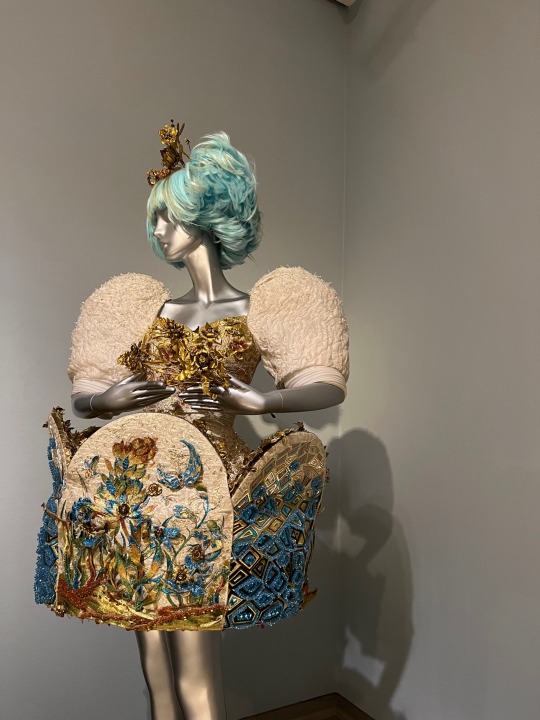
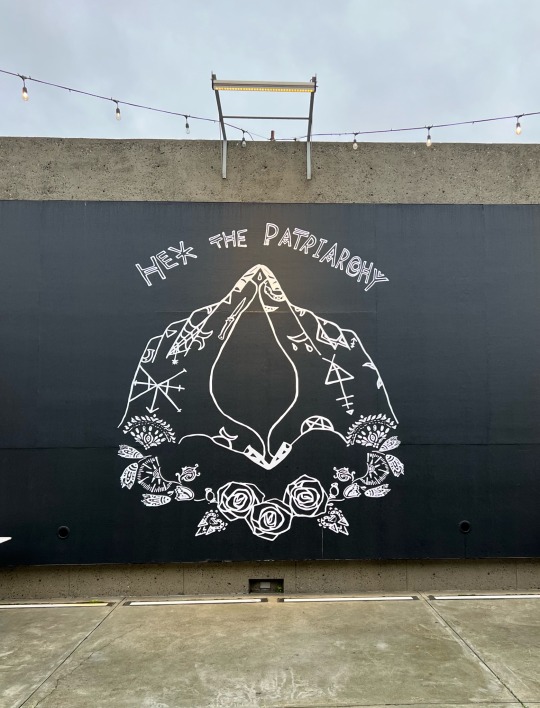
#5 things#severance#wednesday#everything everywhere all at once#eeaao#glass onion#knives out 2#guo pei#hella feminist#san francisco california#oakland california#oaxaca mexico#tacoma washington#noor unnahar#danielle evans#lists#best of 2022
5 notes
·
View notes
Link
1 note
·
View note